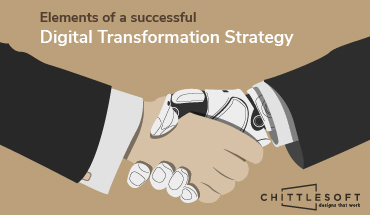
Like any change, digital transformation comes with its challenges. They can be significant if not prepared for beforehand. Not only does the transformation have to be smooth with as few kinks as possible, it has to be sustainable, it has to be acceptable to the people who are in the thick of it (read: your team), and it has to serve a large purpose, i.e., offering a better customer experience. This means that the groundwork laid beforehand for such a transformation must be solid, particularly in traditional industries whose core function is not digital-based, such as pharmaceuticals or automotive. While industries like finance and IT have already implemented digital transformation strategies, other industries are yet to catch up, such as education.
Which elements lay the foundation of a powerful digital transformation strategy?
Robust leadership
For a company that is undergoing digital transformation, leadership with a clear vision and thorough knowledge of the transformation roadmap is vital. This lays a strong foundation for what will be an entirely disruptive change in the business and its functioning. Such clear leadership not only ensures smooth implementation of the process, it also offers guidance to employees who may experience struggles in navigating these changes. Furthermore, a clear idea of what the outcomes of the transformation will be and the goals that need to be achieved will help make the transition easier.
Integration of key digital technologies
Connected cloud with stringent network security measures, artificial intelligence to comb through volumes of customer data and make sense of it, and comprehensive information management systems to store this data are only some of the technologies a digital transformation strategy demands. The integration of these technologies in a business’ core function aids employees and in turn enables them to create a seamless customer experience.
A rich customer experience as the end goal
In keeping with the preceding point, the singular goal of digital transformation is to create and improve value for the customer. Optimizing internal processes through a solid strategy results in a fluid, unique customer experience, which customers should ideally not be able to find anywhere else but in their interactions with you.
Continuous monitoring of the digital transformation process
How does one deliver after developing a strategy for digital transformation? While a goal is easy to set, it is the implementation of the steps necessary to achieve that goal that is the challenge. Because digital transformation is an expensive affair that is fairly large scale, monitoring its impact continuously is critical. Collecting key analytics information allows businesses to tweak their transformation strategy at each step to obtain the best results.
The foundation of a digital transformation strategy containing the aforementioned elements will ensure a smooth experience for your company, your team, and your customers. We at Chittlesoft are here to help you create this unique experience by incorporating these elements into your digital transformation experience. Let’s get in touch and talk about what we can bring to the table to help you meet your goals in this area.



